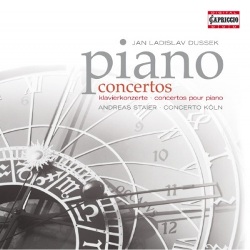Jan Ladislav Dussek – Piano Concertos (2001)
Jan Ladislav Dussek – Piano Concertos (2001)

Piano Concerto in G minor Op.49 (50) (Craw WVZ 187) 1. I. Allegro 2. II. Adagio 3. III. Rondo: Allegro non troppo Piano Concerto in in B flat major Op.22 (Craw WVZ 97) 4. I. Allegro non troppo 5. II. Larghetto non tanto 6. III. Rondo: Allegro non tanto 7. Tableau Marie Antoinette Op. 23 (Craw WVZ 98) Andreas Staier – piano Concerto Cologne Jean-Michel Forest, voice Recorded in the Broadcasting Room of the German National Radio (Deutschlandfunk) in Cologne, Germany, from 24th to 28th November 1992.
A co-production of Deutschlandfunk and Capriccio. Released in 1995 as Capriccio 10 444. Total playing time: 66'35".
Dussek appears to be one of those forgotten "giants" of a byegone age. Born in Bohemia in 1760, he spent most of his life "on the road", travelling throughout Europe giving virtuoso performances on the newly-popular fortepiano, publishing his own compositions and generally making a name for himself which was, in his day, second to (almost) none. Of particular interest is his relationship to the fortepiano manufacturer Broadwood, whom he managed to convince to extend the range of the English-style fortepiano first to five-and-a-half, then to six octaves. The fortepiano used on this recording is an English Broadwood with five-and-a-half octaves from the collection of French specialist Jérome Hantai, made in 1806 and corresponding to Dussek's own specifications.
The front cover of the booklet advertises the CD as "Piano Concertos of the Beethoven Area" [sic!], of course Capriccio meant to write "Era". This subtitle is true, as long as one is aware that Dussek, travel as he might, never seems to have played in Vienna (Hamburg, Paris, London, Berlin and Prague seem to have been his most important points of call). Dussek is still an 18th century composer, and unlike Beethoven he does not seem to have developed his music beyond the limits of what is generally termed "classical". However, the piano concertos played here, although not quite as inspired as Beethoven's, show him to have been a past master of piano technique, a showy virtuoso (he is said to be the first performer who placed the piano sideways on the stage so that the audience could see his hands while playing) who made use of the whole range of the extended keyboard to produce music which is attractive, impressive and very difficult to play. The orchestral accompaniment, again not quite as brilliant as the ones by Beethoven, is equally well-constructed, with the piano weaving filigree patterns between tutti outbreaks. The orchestra is a large one, consisting here of six each of first and second violins, four violas, three cellos, two double basses, two each of flute, oboe, bassoon, clarinet, horn and trumpet and a set of timpani.
Andreas Staier is probably the ideal interpreter of this music, being both a fortepiano virtuoso and an expert on the music of the late 18th and early 19th centuries. Both he and Concerto Köln fulfil every requirement for this music, and the Deutschland-Funk engineers have captured everything clearly, so that I doubt if there will so soon be a rival to this recording. If I give it four stars, instead of five, it is merely to indicate that I still think Beethoven is the greater genius.
The CD comes with a booklet in three languages with essays on Dussek's life, on the music played here, and on the instrument concerned. Andreas Staier adds a note explaining why he has added an introduction to the third movement of Dussek's Op. 22 which, strangely enough, remains entirely in one key, which Staier finds too much of a good thing. Unfortunately, the English translation of the notes is full both of mistranslations and grammar mistakes; if possible, I recommend reading them in the German original. --- Leslie Richford (Selsingen, Lower Saxony)
This delightful album was recorded in 1992 in Cologne; at the time of its 2011 issue by the Capriccio label, it was still one of the few available recordings of the music of Jan Ládislav Dussek, who wielded more of an influence on Beethoven than the other way around. The Piano Concerto in G minor, Op. 49, was composed in 1801, and in its expansive first movement, noble Adagio, and briskly folkish finale it seems a clear forerunner to the music of Beethoven's middle period. Both composers exploited the resources of the muscular pianos made by Scots-British manufacturer John Broadwood, a splendid 1806 example of which is played here by German historical keyboard specialist Andreas Staier. The Piano Concerto in B flat major, Op. 22, is an earlier work, with all three movements curiously in the same key; it is less innovative but nevertheless has a voice distinct from that of Mozart and Haydn. Most interesting of all just for the sheer surprise value may be the Tableau "Marie Antoinette," Op. 23: a programmatic representation of the fate of Marie Antoinette up to her death, complete with falling guillotine. These events are recounted in short statements in French. At first the words are given and then are followed by music, but later in the piece they begin to overlap in the manner of a movie score, which is a very effective device. The booklet includes commentary, with a useful biography of Dussek (he led a very exciting life). The Marie Antoinette texts are given only in French and German, but they're not long, and a smattering of either language would be enough to follow the action. A terrific release from the performer who is perhaps the most imaginative of those specializing in keyboard music of the late 18th century. --- James Manheim, allmusic.com
download: uploaded anonfiles yandex 4shared solidfiles mediafire mega filecloudio
Zmieniony (Sobota, 02 Listopad 2013 20:28)








